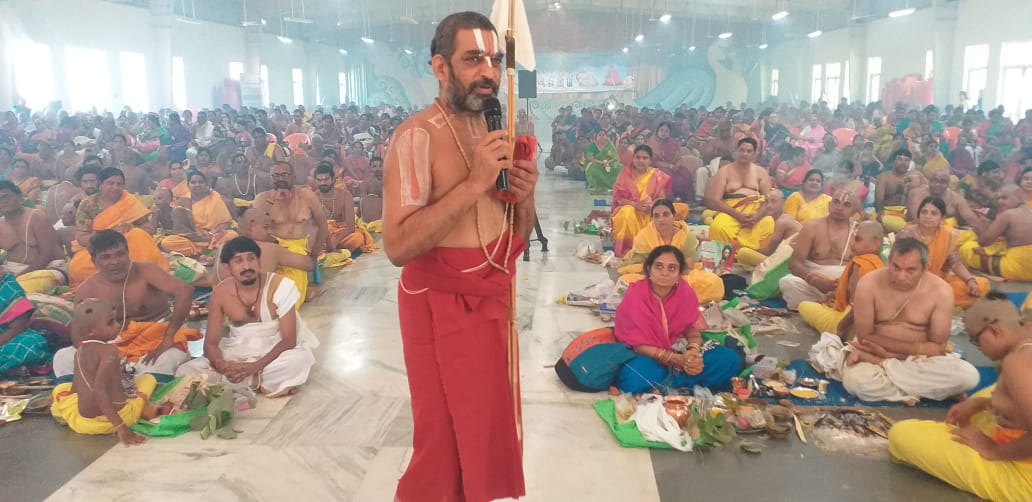It was the day when more than a hundred young boys came together at JIVA asram for the sacred thread ceremony, (the upanayanam) followed by panchasamskara – the initiation to Ashtakshari mantra. One of those young boys had a little baby sister (about an year old) who was sitting on her mother’s lap and wondering what was happening. As Swamiji was explaining the process and purpose of both these divine steps of a vedic path, the girl noticed Him. When she saw Him from close, she starred at the ‘red and white’ mark (the thilak or urdhva pundram, urdhva meaning upwards; pundram means mark) on His forehead. She seemed fascinated by it. She moved her head in the same direction as Swamiji moved, for close to 10 full minutes. She was also looking at her mother’s forehead to see if she has it too. Her mother has a sticker that is red in colour, but not as long as Swamiji’s, and there was no white mark around it.
Was she wondering what these meant? Did she like the colours? Did she like the shape? We don’t know exactly what went in her mind, but it was evident that she was captivated by it.
Fortunately for all of us, Swamiji explained why He puts the bold red and the pleasant white mark on His forehead. Not only Swamiji, the presiding Deity of every Vyshanava temple (centres of divine inspiration) such as Sri Rangam, Thirupathi, Melkote, Kanchi Varadaraja Swami and many others have the same mark on the forehead.
The shape denotes upward progression. It signifies how one must aim to attain a higher state. That is why the shape is long and upwards.
Now that we know what the shape signifies in brief, let’s look at the colours. Why Red and White?

The red colour denotes love. It signifies how one’s purpose in life is to share whatever God gave them (materialistic and non-materialistic) with all those in need. True happiness never comes from enjoying by oneself. Elders say, even if you cry – do it in presence of a group. You may retrospect by yourself for some time, but in the end, it is about reflecting what you are by giving back to everyone around you. When you say give back – it is never to make the other person lazy, one must adopt right methods to invoke the hidden talent and spirit in everyone.
The white colour denotes peace. Pleasant state of mind is an abode of good choices and right decisions. If you are working constantly and your heart is not at peace, then there is something that must change – either what we do or how we think. The white colour reminds us how our goal is to remain peaceful and pleasant. Sometimes, we mistake peaceful state of mind with a passive attitude. But, that’s not true. An active involvement with right thoughts resulting in good conduct drives a peaceful state of mind.
The base line denotes Vedic wisdom that is regarded as the best basis to answer all our questions to keep our mind peaceful and drive our actions by love.

This urdhva pundram on forehead reminds us of the path and the purpose of life. It is one of the five samskaras given as part of mantra initiation. [Reference: Vishnu Thilaka Samhitha]
– From the discourse of Sri Chinna Jeeyar Swamiji
– 27th June 2019
– As part of Upanayanam and Samasrayanam event
– JIVA, Sri Ram Nagar

During the sacred thread ceremony, Swamiji talked about how every family which belongs to the lineage of Vedic tradition must make efforts to take it forward to their next generation. From lakhs of years, the tradition has taken its journey and reached our generation.
Question yourself: Do you want to be a blocker and terminate the Vedic practises and the wisdom, or do you want to be a carrier and pass it onto your next generations?
- If you block the flow, you are missing the opportunity to convey your gratitude to the Supreme power, God.
- If you block the flow, you will lose the opportunity to seek His refuge from the cycle of pains and pleasures.
- If you block the flow, all you are doing is living the life of an animal in a human body…!


